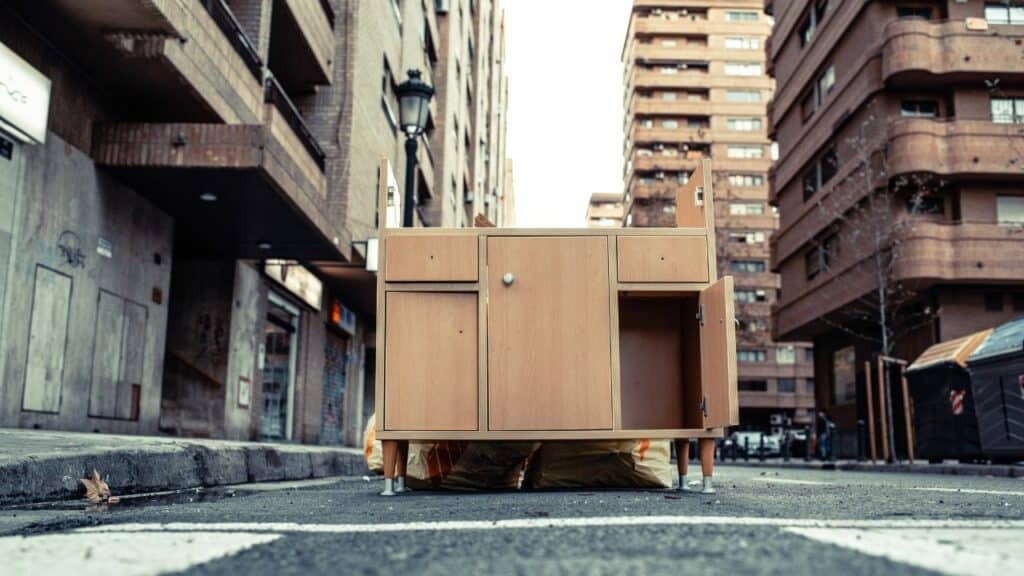
The time has come. You’re replacing that worn-out sofa, the chipped dining table, or the creaky bed frame. Perhaps you’re downsizing, redecorating, or simply upgrading your living space. While the prospect of new furniture is exciting, the question of what to do with the old pieces looms large. Traditionally, furniture disposal has often meant a trip to the landfill, contributing to the ever-growing mountain of waste. However, in an era of heightened environmental awareness, a more responsible and sustainable approach is crucial. This article delves into the intricacies of eco-friendly furniture disposal, providing a comprehensive guide to minimizing waste and embracing greener practices.
Understanding the Environmental Impact of Traditional Furniture Disposal:
Before exploring sustainable alternatives, it’s essential to understand the detrimental impact of conventional disposal methods. Landfills are overflowing with discarded furniture, much of which contains materials that take decades, if not centuries, to decompose. Wood, fabrics, foams, and metals release harmful chemicals and greenhouse gases as they break down, polluting soil, water, and air. Moreover, the sheer volume of furniture waste contributes to deforestation, as more trees are felled to produce new pieces. This linear “take-make-dispose” model is unsustainable and necessitates a shift towards a circular economy where resources are reused and recycled.
The Power of Donation: Extending the Lifespan of Your Furniture:
One of the most impactful ways to reduce furniture waste is through donations. Numerous charities and non-profit organizations accept gently used furniture, providing it to individuals and families in need. Local charities, shelters, and community centers often have programs that distribute furniture to those who are struggling to furnish their homes. Before donating, ensure your furniture is in good condition, clean, and free from major defects. Consider organizations like the Salvation Army, Goodwill, Habitat for Humanity ReStore, and local community-based groups. Many of these organizations offer free pick-up services, making the process convenient and hassle-free. By donating, you’re not only reducing waste but also contributing to social good and giving your furniture a second life.
Responsible Recycling: Breaking Down Furniture for Material Recovery:
When donation isn’t feasible, recycling offers a viable alternative. Many furniture pieces contain recyclable materials, such as wood, metal, and certain types of plastic. Contact your local waste management authority or recycling center to inquire about furniture recycling programs. Some municipalities offer curbside pick-up for bulky items, while others have designated drop-off locations. Deconstructing furniture before recycling can significantly improve the process. Separate wooden components from metal frames, remove upholstery, and sort materials accordingly. Metal components, such as springs and frames, are often highly recyclable and can be processed into new metal products. Wood can be chipped and used for mulch, compost, or engineered wood products. Even some fabrics and foams can be recycled, though the process is more complex. Specialized recycling facilities may be required.
Repurposing and Upcycling: Unleashing Creativity and Reducing Waste:
Repurposing and upcycling offer creative and sustainable ways to give old furniture a new purpose. Instead of discarding an outdated dresser, consider transforming it into a stylish bathroom vanity or a unique storage unit. An old wooden pallet can be repurposed into a rustic coffee table or a vertical garden. With a little imagination and some DIY skills, you can breathe new life into your furniture and create one-of-a-kind pieces. Upcycling not only reduces waste but also adds character and personality to your home. Explore online resources, such as Pinterest and YouTube, for inspiration and tutorials. Local workshops and community centers may also offer upcycling classes and resources.
Responsible Disposal of Non-Recyclable Items:
Unfortunately, not all furniture components are recyclable or reusable. Certain types of treated wood, heavily damaged items, or materials contaminated with hazardous substances may require disposal. In such cases, it’s crucial to dispose of these items responsibly. Check with your local waste management authority for guidelines on proper disposal. Some municipalities offer special collection days for bulky waste or hazardous materials. Avoid illegal dumping, as it can harm the environment and lead to fines. If possible, consider dismantling non-recyclable items to reduce their volume and make them easier to transport.
Choosing Eco-Friendly Replacement Furniture:
The most sustainable approach to furniture disposal is to minimize waste in the first place. When purchasing new furniture, opt for eco-friendly materials and manufacturing processes. Look for furniture made from sustainably harvested wood, such as FSC-certified timber. Consider furniture made from recycled materials, such as reclaimed wood or recycled plastic. Choose pieces with durable construction and timeless designs, ensuring they last longer and reduce the need for frequent replacements. Prioritize brands that embrace sustainable practices, such as using non-toxic finishes and minimizing packaging waste. Supporting eco-conscious businesses contributes to a more sustainable furniture industry.
The Role of Professional Furniture Removal Services:
For those who lack the time, resources, or physical ability to handle furniture disposal themselves, professional furniture removal services offer a convenient solution. However, it’s essential to choose a service that prioritizes eco-friendly practices. Inquire about their recycling and donation policies. A reputable company should strive to divert as much waste as possible from landfills. Some companies even offer deconstruction services to separate recyclable materials. Before hiring a service, request a detailed quote and ensure they are licensed and insured.
Related: Furniture Finesse: Choosing Pieces That Define Your Style!
Community Initiatives and Programs:
Many communities are implementing innovative programs to promote eco-friendly furniture disposal. Community swap shops, repair cafes, and tool libraries offer opportunities to exchange, repair, and reuse furniture. These initiatives foster a sense of community and reduce waste by extending the lifespan of existing items. Local councils and environmental organizations may also offer educational workshops and resources on sustainable furniture disposal. Participating in these community-based programs can contribute to a more sustainable and circular economy.
The Future of Sustainable Furniture Disposal:

The future of furniture disposal lies in a circular economy where resources are continuously reused and recycled. Advancements in recycling technologies and material science are paving the way for more efficient and sustainable disposal methods. Extended producer responsibility (EPR) schemes, which hold manufacturers accountable for the end-of-life management of their products, 1 are gaining traction. These schemes incentivize manufacturers to design products that are easier to recycle and reuse. Embracing a culture of conscious consumption and responsible disposal is crucial for creating a more sustainable future.
Related: How a Small Folding Table Can Transform Your Home Decor
People Also Ask (FAQs):
- Q: Can I put my old mattress out for regular trash pickup?
- A: It varies by location. Many municipalities have specific regulations for mattress disposal due to their bulk and material composition. Check with your local waste management authority for guidelines. Some areas have mattress recycling programs or special collection days.
- Q: How can I find a charity that accepts furniture donations?
- A: Online search engines and directories can help you locate charities in your area that accept furniture donations. Websites of organizations like the Salvation Army, Goodwill, and Habitat for Humanity ReStore provide information on donation guidelines and locations.
- Q: Are there any apps or online platforms for selling or giving away used furniture?
- A: Yes, platforms like Facebook Marketplace, Craigslist, and Nextdoor allow you to connect with potential buyers or recipients in your local area. Apps like OfferUp and Letgo also facilitate the exchange of used items.
- Q: What do i need to know about treated wood disposal?
- A: Treated wood often contains chemicals that can leech into the ground. Therefore it is recommended to bring treated lumber to a facility that is able to dispose of it safely. Check local regulations.
- Q: Are foam cushions recyclable?
- A: Foam cushions can be very difficult to recycle, and many locations don’t offer the service. However, some recycling plants exist that have the capabilities to do so. Search for those in your local area.
Conclusion:
Eco-friendly furniture disposal is a crucial step towards creating a more sustainable and environmentally responsible society. By embracing donation, recycling, repurposing, and responsible disposal practices, we can minimize waste and reduce our environmental footprint. Furthermore, through making educated choices when obtaining new furnishings, we help contribute to a stronger circular economy. The choices we make regarding the disposal of our furniture have long-lasting effects. Let’s work together to create a greener and more sustainable future, one piece of furniture at a time.






